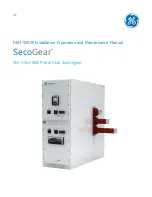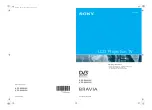
SecoGear – Installation, Operation and Maintenance Manual 13 of 56
Every shipping section leaving the factory is plainly marked
with the case number, requisition number, and customer order
number. If the equipment has been split for shipment, the section
numbers of the equipment enclosed in each shipping package
are identified. To avoid the loss of any parts when unpacking,
carefully check the contents of each container against the
packing list before discarding the packing material.
The contents of each shipping package are listed on the Master
Packing List. In addition, this list includes the number of the
shipping crate that contains miscellaneous parts needed to
install and operate the equipment (such as hardware, contact
lubricant, touch-up paint, circuit breaker closing devices).
Normally, such devices are packed in a cardboard carton secured
in an empty section compartment. Large items, such as the lift
truck and dollies, are always shipped in separate crates
or cartons.
Inspecting for Damage
All equipment leaving the factory is carefully inspected and
packed by personnel experienced in the proper handling
and packing of electrical equipment. Upon receipt of any
equipment, immediately perform a visual inspection to
ascertain if any damage has been sustained in shipping or
if there are any loose parts.
Circuit breakers will be shipped separately in individual
containers and should be unpacked to visually inspect them for
damage or loose parts as soon as possible after they have been
received. Be sure to inspect all devices mounted or packed
inside compartments of each section to see if any have been
dislodged or damaged.
Filing a Claim
If any damage is evident, or indication of rough handling is
visible, file a claim for damage at once with the transportation
company and notify the nearest General Electric Company
Sales Office immediately. Include any information on damaged
parts, part number, case number, requisition number, etc.
Handling
It is preferable to leave the shipping skids in place under the
switchgear until it reaches its final location. The equipment
should be installed in its final location prior to installing the
circuit breakers.
Enclosure Lifting
The switchgear sections are best handled by lifting with a crane
as shown in Figure 2-1. Removable lifting plates are provided
as standard equipment, on the top of each switchgear section.
Utilize four equal length cables and an overhead crane, each
with a minimum load rating of twice the weight of the shipping
section to be lifted. Estimated weights for shipping splits are
displayed on the drawings in the accompanying bill
of materials.
2. Receiving, Handling and Storage
Receiving
EXAMPLE
The angle between the cables and the top of the equipment
must be at least 45°. If this is not possible because of lack of
headspace, spreader bars must be used. Also, lift cables with
greater load capability may be necessary, depending upon the
angle between the cables and the crane hook.
Connect a cable from the crane to the four lifting plates
located on the top-front and rear of the switchgear
(Figure 2-1 and Figure 2-2).
Figure 2-1: Recommended Lifting Method (Front View)
Spreader bars
(not provided
with equipment)
Switchgear section weight = 5,000 lbs.
The crane and the four lift cables must have a
minimum load lifting capacity of 10,000 pounds.





































